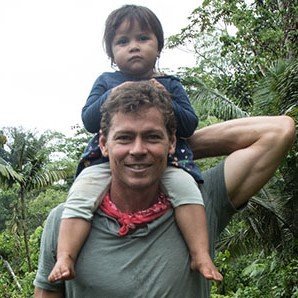Indigenous People Blocked Ecuador Oil Auction in Growing Fight to Save Amazon

When Indigenous people fight to defend and enforce their land rights, they are protecting their future—and ours.
This summer, a court in Ecuador issued a ruling with profound implications for the urgent fight to save the imperiled Amazon rainforest. The decision effectively blocked a planned government oil auction that threatened half-a-million acres of some of the world’s most biodiverse primary rainforest.
The broad outlines of the situation are sadly familiar to similar cases found throughout the Amazon region: In pursuit of foreign investment, the government sought to partner with foreign firms to develop large swaths of ecologically fragile rainforest. As is often the case, these forests were the ancestral lands of Indigenous inhabitants who were not informed about—and did not approve—the arrival of industry on their territory.
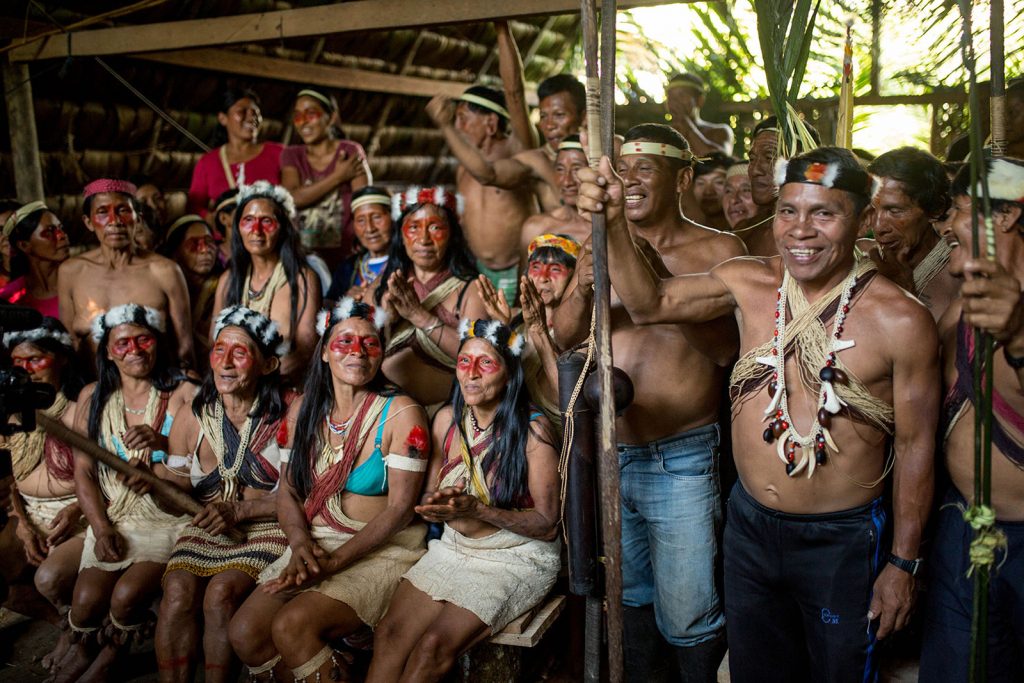
Waorani men and women participate in an assembly in ancestral Waorani territory, Pastaza, Ecuadorian Amazon.(Photo credit: Amazon Frontlines)
The Waorani villagers who are plaintiffs in the case have millennia-deep roots in the region. They have seen the effects of oil blocks in other parts of the Ecuadorian Amazon, and knew that the planned auction threatened their survival and way of life. They also knew their rights: Like all Indigenous peoples, they hold an internationally recognized right to informed consent when it comes to the “development” of their ancestral lands. When Indigenous people fight to defend and enforce these rights, they are protecting their future and ours. The fate of the global climate hinges on empowering the Indigenous peoples who help preserve nearly a quarter of the Amazon across at least seven nations, and who represent a powerful buffer against the destruction of a biosphere that regulates our planet’s flows of oxygen, carbon and fresh water.
Below are eight important lessons of this historic victory.
1. Healthy Cultures, Healthy Forests
The Waorani people are legendary hunter-harvesters of the south-central Ecuadorian Amazon. For centuries before the arrival of missionaries in the 1950s, they lived in harmony with and preserved their rainforest home. They developed a rich culture marked by high craftsmanship and artistry, profound spirituality and a sophisticated understanding of the natural world and its complex systems of plant and animal life.
The Waorani and hundreds of other Amazonian Indigenous cultures have been under enormous strain since the arrival of industry in the last century. Indeed, it is impossible to separate the physical pollution of the rainforest from the cultural disruption experienced by the people who live there. The relation between them is not causal but cyclical: The growth of oil roads, mono-crops and mining jeopardizes Indigenous peoples’ ability to survive off the land sustainably and in balance with the forest. It creates a dynamic that forces Indigenous youth to abandon tradition and find work in the very industries that threaten their forest homes. The Waorani victory is important not only because it protects trees, but because it protects the culture that can continue to protect trees for centuries to come.
2. Defining the Narrative: Maps, Technology, Stories
The fate of the rainforest will be determined by how the world chooses to see it and conceive of its riches. Is the Amazon basin merely a green mass of undifferentiated land, crisscrossed by hundreds of unremarkable rivers? Is it a grid of resource concessions, notable for what’s under the ground, and convertible into currencies and value on international commodity markets? Or is the Amazon a tapestry of delicate and overlapping systems containing immeasurable biological, ecological and cultural treasures?
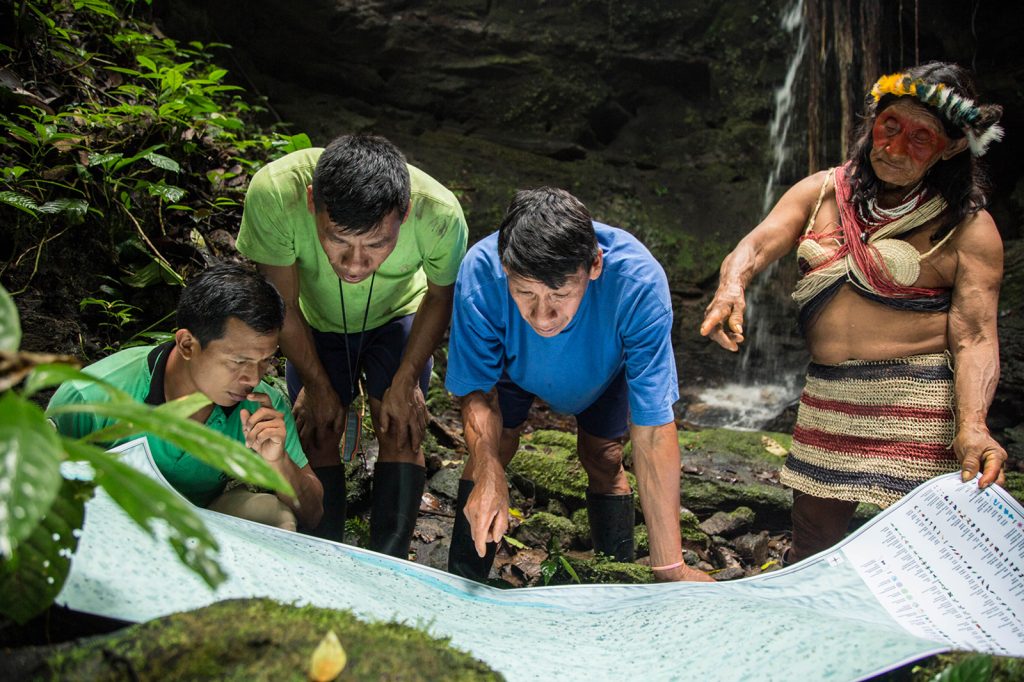
The Waorani communities’ maps identify historic battle sites, ancient cave-carvings, jaguar trails, medicinal plants, animal reproductive zones, important fishing holes, creek-crossings, and sacred waterfalls. (Photo credit: Amazon Frontlines)
At their most basic level, these are competing stories, conflicting narratives that begin with the maps that we use to represent the land. One of the ways the Waorani won the narrative was by using their own maps and telling their own stories. A territorial mapping project showed what the state and company maps left out: the turtle nesting grounds, the sacred sites, the ways the rivers fed the forest and each other. Through this and other tools—drone videos, testimonies, camera-trap images, even selfies—they illustrated the many ways that their culture, and everything it protected, is more precious than oil and greed. They also showed how hunter-harvester people can leverage technology and social media on their own terms to challenge a mighty industry and capture the imagination of global civil society.
3. The Power of Legal Precedent
Rights enshrined in international laws and national constitutions are not worth their ink without enforcement. As with any laws, they are more likely to be enforced when they rest on firm precedent, locally and around the world. For too many years, the Waorani have seen the Ecuadorian government ignore their constitutional and international obligations to inform and acquire consent, and allow companies to pollute Indigenous lands.
Because the Waorani demanded the government respect the law and the constitution, Indigenous peoples across the Amazon can now draw inspiration and tactical lessons from the Waorani legal success in linking the right to self-determination to the right to free, prior and informed consultation. Its example puts the country and the region one step further toward redefining the legal framework for Indigenous rights.
Although the first battle has been won, the struggle is ongoing. It is likely that the Ecuadorian government is still seeking to auction 7 million acres in the country’s central rainforest to oil companies.
4. Climate Change and Interconnectedness
The Waorani victory is a victory for the climate: It keeps 500,000 acres of trees working as carbon vacuums and prevents the pumping of millions of gallons of crude oil that would have been shipped to California for refining and distribution to gas stations across the United States. Based on previous calculations of tree cover loss in Shushufindi, a canton in Ecuador’s Sucumbíos Province, which is similar in size, it can be estimated that in aggregate over the next 10 years, the Waorani victory will have averted approximately 19 million metric tons of carbon dioxide emissions—the equivalent of the greenhouse gases emitted from roughly 4 million passenger cars in one year.
After the oceans, the rainforests are the world’s most important carbon sinks, a sprawling continent’s worth of vegetation that absorbs and keeps carbon out of the atmosphere for millennia. As the traditional inhabitants and defenders of this carbon sink, Indigenous communities are the “secret weapon” in its defense, according to a growing body of research. A report by a group of leading research centers estimates that Indigenous lands cover around a quarter of the world’s above-ground tropical carbon sinks.
The importance of the Amazon system extends beyond carbon. Its hydrological cycle involves an estimated one-fifth of the planet’s freshwater supply, and any decline in rainfall and evapotranspiration in the Amazon—the consequence of deforestation and contamination—has far-reaching effects, including drought in breadbaskets throughout the hemisphere and less river-feeding snowpack in the mountains of the Pacific Northwest.
5. Women in Front
The Waorani struggle has involved three generations of women fighting to protect their culture, territories, and sources of food and fresh water. As traditional caretakers of the family, women are often the most concerned with the fate of the forest—as it has a direct implication in the quality of life for future generations. While men have certainly been involved in the Waorani’s struggle, there has been a notably greater number of women at the forefront.
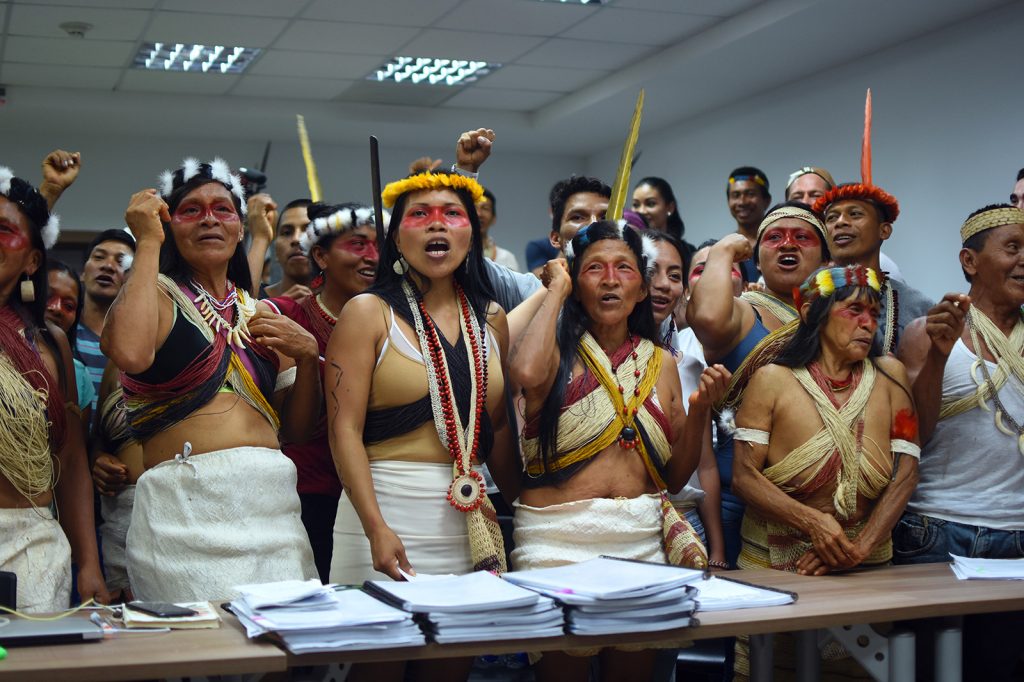
The Waorani people sing after a long hearing as they await a three-judge panel ruling at a Provincial Court in Pastaza, Ecuadorian Amazon. (Photo credit: Amazon Frontlines)
Dozens of Waorani women participated in the court proceedings, and led the media events surrounding the hearing. They arrived bearing examples of traditional Waorani culture and craftsmanship—palm-woven baskets, clay pots and food grown in traditional gardens. When the women felt they were being disrespected by court and government officials, they halted the insults by breaking out into spontaneous song. All of this helped capture the imagination of the world with their spirit and their conviction and courage.
One of the lead plaintiffs in the case is Nemonte Nenquimo, a Waorani mother and president of the Waorani communities on the Pastaza river. “We are the caretakers of the forest, and we will continue defending it as our ancestors have done for thousands of years,” Nenquimo told reporters outside the courtroom during this summer’s hearing. “As women, we are fighting for our children, for our families, for our communities and for our Mother Earth. We will never allow the oil companies to enter our territory. Our forest is not for sale, and this is our decision.”
6. Protecting Rivers and Water
Life in the Amazon is lived on rivers. From fishing to bathing to providing drinking water, the rivers are the central arteries of everyday life. Because all of the rivers in the Amazon flow from or into other rivers—and are often located in floodplains—it is all but impossible to isolate or contain contamination. This was made tragically clear in the legacy of the U.S. oil company Texaco (now a subsidiary of Chevron), which in the 1960s won a government contract to develop the region’s oil deposits.
Disregarding the health of the forests and the local Indigenous people, the company dumped waste and spilled oil wantonly throughout the forest and into its rivers. Toxic material sometimes appeared as thick sludge on the river, and other times was invisible but no less dangerous to people and wildlife who are exposed to it from the produce grown on contaminated soils, to the water table and the wider food chain.
Researchers at the Manuel Amunárriz Institute of Epidemiology and Community Health in Quito, Ecuador, found a higher than expected incidence of cancer near the oil fields in Ecuador’s Amazon basin, concluding that “the observed excess of cancer might be associated with the pollution of the environment by toxic contaminants coming from the oil production.”
Today, many communities in eastern Ecuador cannot drink from rivers their ancestors used for countless generations. The contamination of the region is not historical but ongoing. Though Chevron no longer operates in the region, regional and Chinese firms continue to engage in oil production at the invitation of the Ecuadorian government.
This is the crucial, local context for the Waorani victory and explains why the villagers refused to allow further destruction of the area’s freshwater sources. Their refusal reflects a global movement—seen throughout Latin America, Africa and Asia, all the way to Standing Rock in the U.S.—to both defend Indigenous rights and lead by example toward a broader and deeper respect for nature as the sacred source of all life.
7. Wildlife and Biodiversity
It is difficult to overstate the bounty of the Amazon’s plant and animal life. Accounting for a tenth of all known species on the planet, the Amazon is an ecosystem without equal. It is also an ecosystem full of mysteries yet to be discovered. Much of the modern pharmacopeia derives from Amazonian plants, and longstanding medical mysteries may yet be solved by researching the flora of a healthy forest.
The northern Ecuadorian Amazon is a tragic example of how the delicate web of life in the rainforest can be ruined within a generation by the arrival of extractive industry. In 1970, the area around Lago Agrio, the region’s biggest city, was one of healthy rivers and forests, full of animal and aquatic life. Now, in villages along the Putumayo and Aguarico, the water is undrinkable and many ancestral hunting grounds are bare, polluted and bisected by roads. Fragmentation is a major threat to biodiversity and wildlife, and the government’s proposed oil blocks would pollute an important biological corridor running across the wider region.
The species-level stakes of Amazon protection were highlighted this May with the release of a landmark United Nations report on biodiversity. The report warned that unless critical ecosystems are protected, as many as 1 million species are threatened with near-term extinction. The Waorani have won a battle not only for themselves, their children and the planet, but also for the jaguars, monkeys, birds and ants.
8. Union of Indigenous Nations
The Indigenous nations of the Ecuadorian Amazon understand themselves to share a common struggle. Many of these peoples joined the Waorani in solidarity outside the courtroom, traveling from distant communities in the country’s north and south. They marched with the Waorani in the streets, they submitted amicus briefs and they returned to their communities to share what they had learned to better organize for the future.
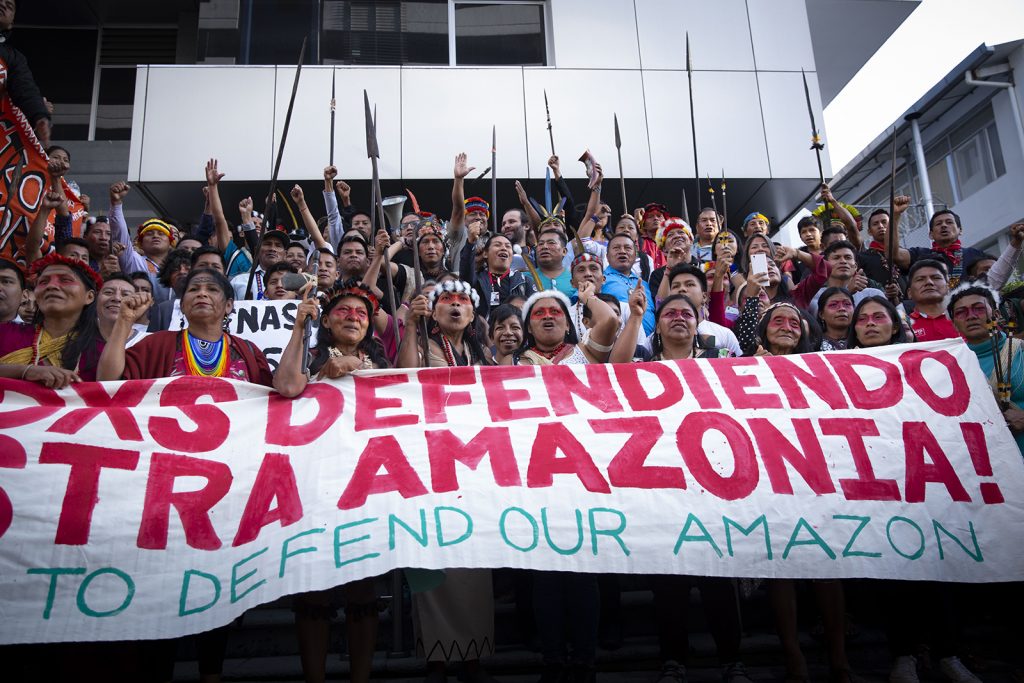
The Waorani people mobilize and unite with other indigenous nations including the Kichwa, Sapara, Andoa, Shiwiar, Achuar and Shuar, whose lives and lands are also threatened by oil drilling in the Ecuadorian Amazon. (Photo credit: Amazon Frontlines)
“We have united with our Waorani brothers and sisters because we share the same struggle and dream: to protect our forest and to continue being who we are, as Indigenous peoples,” said Alex Lucitante, a Kofan leader. “We will continue to unite forces and build strength between our peoples to resist the threats to our territories. Without unity, there can be no triumph.”
This model of multinational mobilization and solidarity—across Ecuador and the entire Amazon—will be crucial to defeating the “extraction at-all-costs” paradigm that threatens the region. The Waorani alliance was a powerful demonstration of this. Now the challenge is to scale up the precedent and further empower those defending the 7 million acres of Indigenous land still targeted by the government and the oil industry.
Sign here to stand with the Amazon’s oldest guardians to protect a forest we all depend upon at this critical moment.
This article first appeared on Truthout and was produced in partnership with Amazon Frontlines and Earth | Food | Life, a project of the Independent Media Institute. An earlier version of this article appears at Amazon Frontlines.

